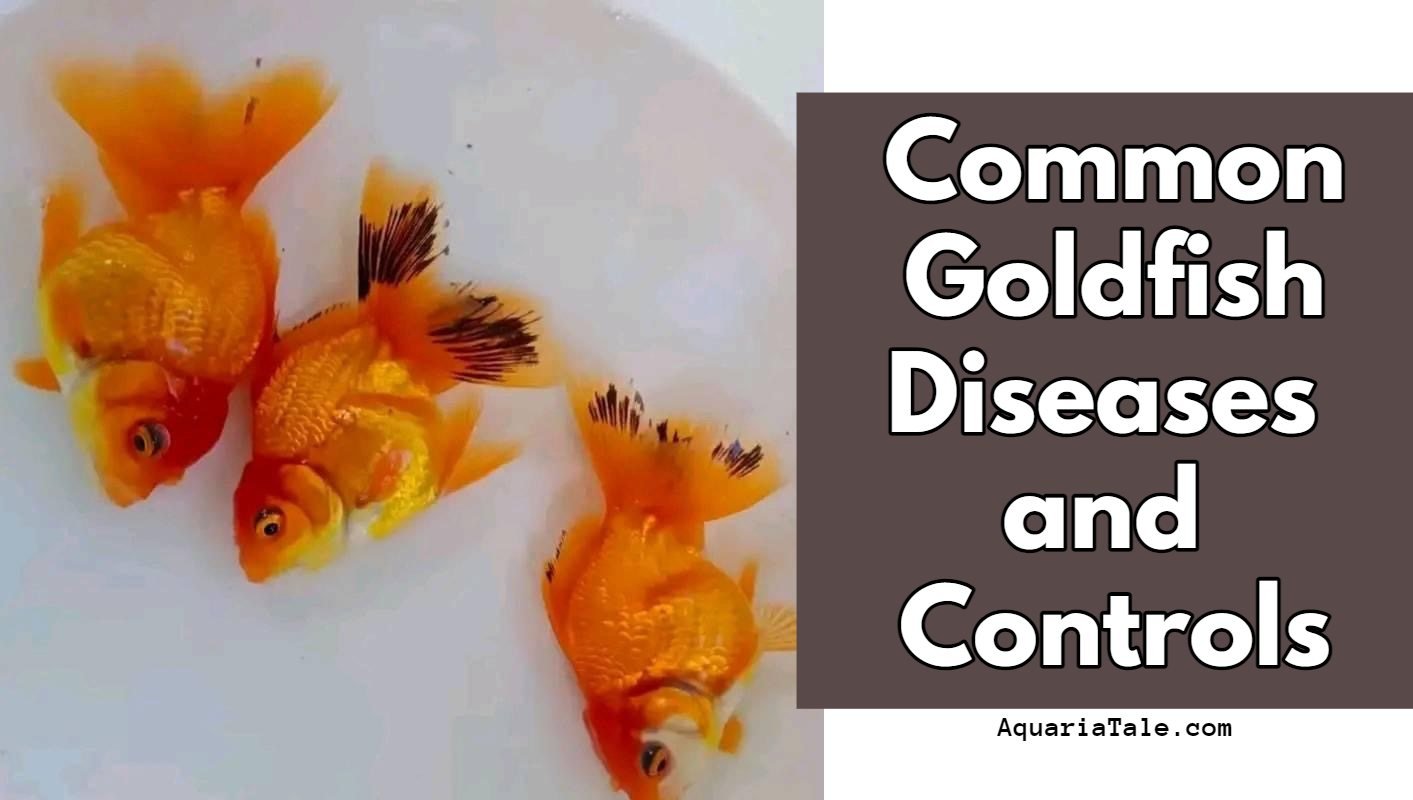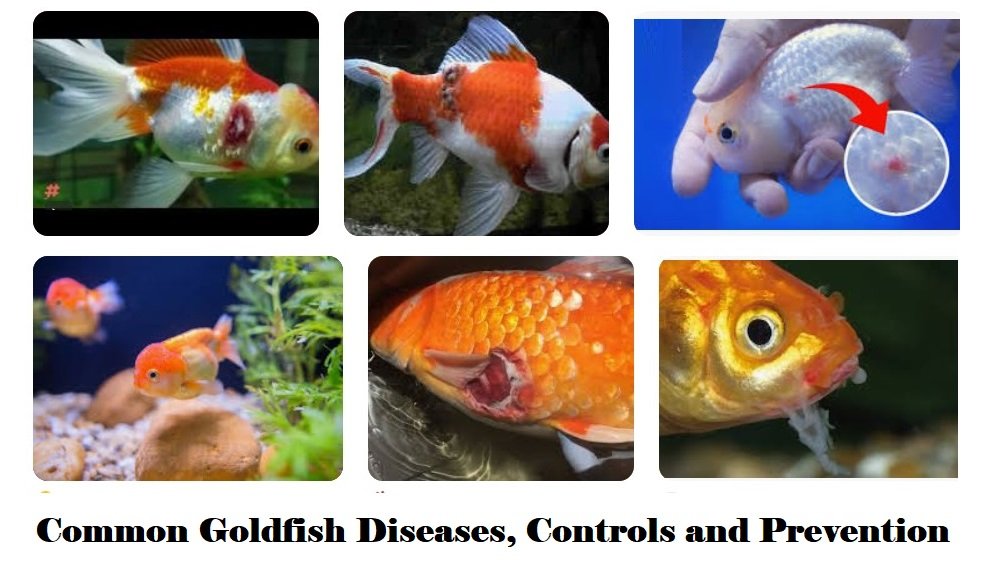Goldfish are a popular pet for both kids and adults, due to their low maintenance and calming presence. But even though they don’t require a lot of care, goldfish can still get sick.

There are many aquarium fish diseases. Among them; Goldfish are susceptible to a variety of diseases, but many of these diseases can be treated with simple interventions like changing the water quality or using medications like antibiotics or anti-parasitic medications .
If you think your goldfish may be sick, it’s important to consult your veterinarian so they can properly diagnose and treat the disease .
Here, we’ll go over some of the most common goldfish diseases and what you can do to prevent them.
10 Common Goldfish Diseases and Controls
Goldfish are a popular pet, but they are also susceptible to a variety of diseases. Here, we will take a look at some of the most common goldfish diseases and their treatments.

1. Dropsy
Dropsy is a disease that causes the fish to bloat and the scales to protrude. It is often caused by poor water quality or a bacterial infection. Treatment involves improving the water quality and treating the infection with antibiotics.
Symptoms: Bloating, pinecone-like scales, lethargy, and loss of appetite.
Causative Agent: Bacteria such as Aeromonas or Pseudomonas.
Treatment: Antibiotics, clean water, and proper nutrition.
2. Neurofibroma
Neurofibroma is a tumor that grows on the nerves. It is usually benign, but can be fatal if it presses on the brain. Treatment involves surgery to remove the tumor.
3. Fluke
Fluke is a parasitic infection that can cause inflammation and bleeding. Treatment involves using an anti-parasitic medication.
Symptoms: Mucus covering the gills or body, Gills look like they’ve been chewed, Reddened skin, Scratching against objects, Fish move their gills rapidly.
Causative Agent: Commonly called Gill (Dactylogyrus spp.) or Skin Flukes (Gyrodactylus spp.)
Treatment: The most effective treatment for flukes is Praziquantel. And After you have treated, use any antibiotics to treat wounds.
4. Anchor worm
Anchor worm is a parasitic infection that causes the fish to itch and scratch. Treatment involves using an anti-parasitic medication.
Physical Signs: Redness around the anchor, Ulcers can appear, Inflammation on body, Tiny white-green or red worms found at the base of fins
Behavioral Symptoms: Breathing Difficulties, Lethargy, Rubbing or flashing against objects
Causative Agent: Caused by Lernaea spp., are parasitic copepod crustaceans that prey on freshwater fishes.
Treatment: Potassium permanganate is considered the best treatment for Anchor Worm, and it can be used as a tank treatment or dip bath method.
5. Fish lice
Fish lice are parasites that attach themselves to the fish’s body. Treatment involves using an anti-parasitic medication.
Physical Signs: Small dark spots on fish body, visible parasites (seen as little green specks). You can see Red markings, ulcers, or inflamed areas where the lice affected.
Behavioral Symptoms: Aggravated and restless, Rubbing against glass or other objects to remove lice
Causative Agent: Caused by Argulus spp. are branchiuran crustaceans that parasitize both marine and freshwater fishes.
Treatment: The most effective treatment against argulusosis is organophosphates, which usually are given as 2 or 3 doses at 1-week intervals to kill emerging larvae and juveniles. Or you also can use Organophosphates tend to be an effective cure.
6. Fin rot
Fin rot is a bacterial infection that causes the fins to disintegrate. Treatment involves using antibiotics and improving water quality.
Symptoms: Frayed or ragged fins, redness and bleeding at the base of the fins.
Causative Agent: Bacteria such as Aeromonas or Pseudomonas.
Treatment: Water Exchange, Antibiotics, clean water, and Proper nutrition. Since it is a Bacterial disease Antibiotic should be applied.
7. Ulcers
Ulcers are open sores that can be caused by bacteria, parasites, or poor water quality. Treatment involves improving water quality and treating the infection with antibiotics or anti-parasitic medications.
8. Fungus
Fungus is a type of infection that can cause white spots on the fish’s body. Treatment involves using an anti-fungal medication.
Physical Signs: Long, white cottony or fluffy strands growing from the body (can also grow on the head and fins), aquarium debris can give them a brown, reddish or green coloration.
Behavioral Symptoms: Itchy, weight loss, Not usually affected until later stages
Causative Agent: May caused by Saprolegnia and Ichthyophonus hoferi fungus species.
Treatment: API FUNGUS CURE fish remedy works best when used to treat fungal infections. You can also use malachite green.
9. Carp pox
Carp pox is a viral infection that causes lesions on the fish’s body. There is no treatment for carp pox, but it is not fatal and usually goes away on its own within two months.
10. Cloudy eye
Cloudy eye is a condition that causes the eye to become cloudy or opaque. It can be caused by bacteria, parasites, or poor water quality. Treatment involves improving water quality and treating the underlying infection with antibiotics or anti-parasitic medications.
Symptoms: Cloudy white or gray “haze” over the eyes and A loss of vision.
Causative Agent: Streptococcus bacteria is a major cause of cloudy eyes in fish.
Treatment: Feed the fish healthy meals, Increase pH level, Melafix is recommended.
How to Identify a Sick Goldfish?

Goldfish are a popular pet for many people, but they can be delicate creatures. It’s important to know how to identify when your goldfish is sick so you can take steps to make them feel better. Here are a few signs to look for:
Lethargy or listlessness
One of the first signs that your goldfish is sick is a change in their activity level. If they’re normally active and swimming around a lot, but suddenly become lethargic and start floating at the bottom of the tank, it’s a sign that something is wrong.
Loss of appetite
Another sign that your goldfish is sick is a loss of appetite. If they’re not eating as much as usual, or if they’re refusing food altogether, it’s a good idea to take them to the vet to see what’s going on.
Unusual behavior
If your goldfish starts behaving unusually, it could be a sign that something is wrong. For example, if they start swimming erratically or rubbing against the sides of the tank, it’s worth taking them to the vet to get checked out.
Cloudy eyes
Cloudy eyes are another sign that your goldfish is sick. If their eyes appear milky or opaque, it’s a good idea to take them to the vet for an examination.
Spots or lesions on the body
If you notice any spots or lesions on your goldfish’s body, it’s a good idea to take them to the vet right away as this could be a sign of disease or infection.
If you notice any of these signs in your goldfish, it’s a good idea to take them to the vet right away so they can get the treatment they need.
Related Read: How Do You Know Your Goldfish is Sick?
Preventing Goldfish Diseases
The best way to prevent goldfish diseases is to maintain good water quality. This means doing regular water changes (at least once a week), using a filter, and avoiding overfeeding.
You should also quarantine new fish before adding them to your tank to make sure they’re not sick.
If you notice any symptoms of disease in your fish, isolate them from the rest of the tank and treat them immediately.
Conclusion
Goldfish are low-maintenance pets that can bring joy to any home. But even though they’re easy to care for, goldfish can still get sick if they’re not properly cared for.
In this blog post, we went over some of the most common goldfish diseases and how you can prevent them. Remember to do regular water changes, use a filter, avoid overfeeding, and quarantine new fish before adding them to your tank.
If you notice any symptoms of disease in your fish, isolate them from the rest of the tank immediately and start treatment right away.